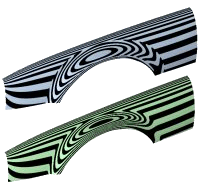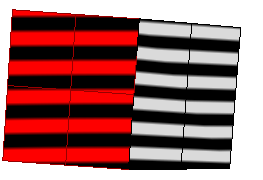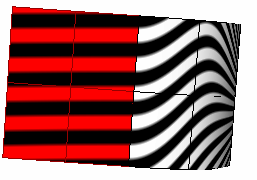![]()
分析
曲面 >
斑馬紋
| 工具列 | 功能表 |
|---|---|
|
|
分析 曲面 > 斑馬紋 |
The Zebra command visually evaluates surface smoothness and continuity using a stripe map.
The Zebra command is one of a series of visual surface analysis commands. These commands use NURBS surface evaluation and rendering techniques to help you visually analyze surface smoothness, curvature, and other important properties.

如果兩個曲面相接邊緣處的斑馬紋相互錯開,代表兩個曲面以 G0 (位置) 連續性相接。
如果兩個曲面相接邊緣處的斑馬紋相接但有銳角,兩個曲面的相接邊緣位置相同,切線方向也一樣,代表兩個曲面以 G1 (位置 + 正切) 連續性相接。以 FilletSrf 指令建立的曲面有這樣的特性。
如果兩個曲面相接邊緣處的斑馬紋平順地連接,兩個曲面的相接邊緣除了位置和切線方向相同以外,曲率也相同,代表兩個曲面以 G2 (位置 + 正切 + 曲率) 連續性相接。BlendSrf、MatchSrf 與 NetworkSrf 指令可以建立有這樣特性的曲面。NetworkSrf 指令只有在以曲面的邊緣為邊緣曲線時才可以選擇 G1 與 G2 連續。
If, when you use the Zebra command, the selected objects do not already have a surface analysis mesh, an invisible mesh will be created based on the settings in the Polygon Mesh Options dialog box.
網格選項
移動滑桿可以簡易控制網格的轉換密度與網格面數。
彩現網格的設定修改後可以用來預覽結果,不滿意可以再進一步修改設定。
開啟網格進階選項對話框。
曲面分析網格會儲存在 Rhino 的檔案裡,這些網格可能會讓檔案變的很大。RefreshShade 指令與 Save、SaveAs 指令的僅儲存幾何圖形選項可以清除檔案中的分析網格。
分析自由造型的 NURBS 曲面必需使用較精細的網格才能得到較準確的分析結果。
| 工具列 | 功能表 |
|---|---|
|
|
|
The ZebraOff command turns off zebra analysis and closes the Zebra dialog box.
Rhinoceros 6 © 2010-2017 Robert McNeel & Associates. 10-一月-2018